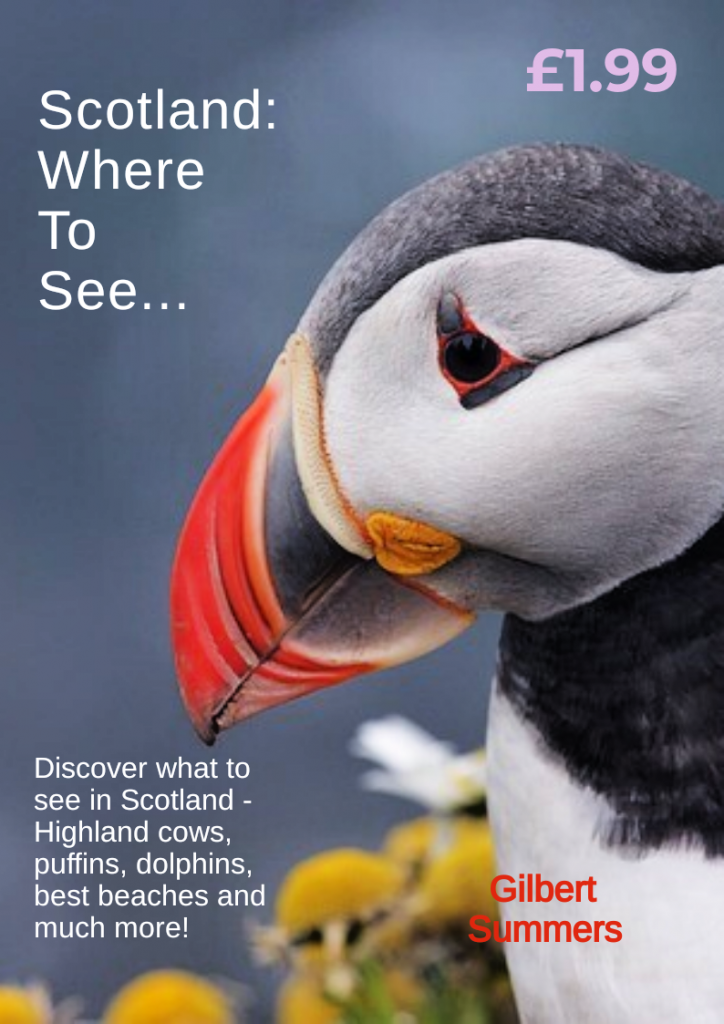Where can you see Highland cows, icons of Scotland? That’s pretty easy. Highland cattle are fairly widespread and here are a few suggestions about where you can find them, as well as some background information you’ll enjoy. Often called hairy coos, their heritage stretches back to the days of the clans.
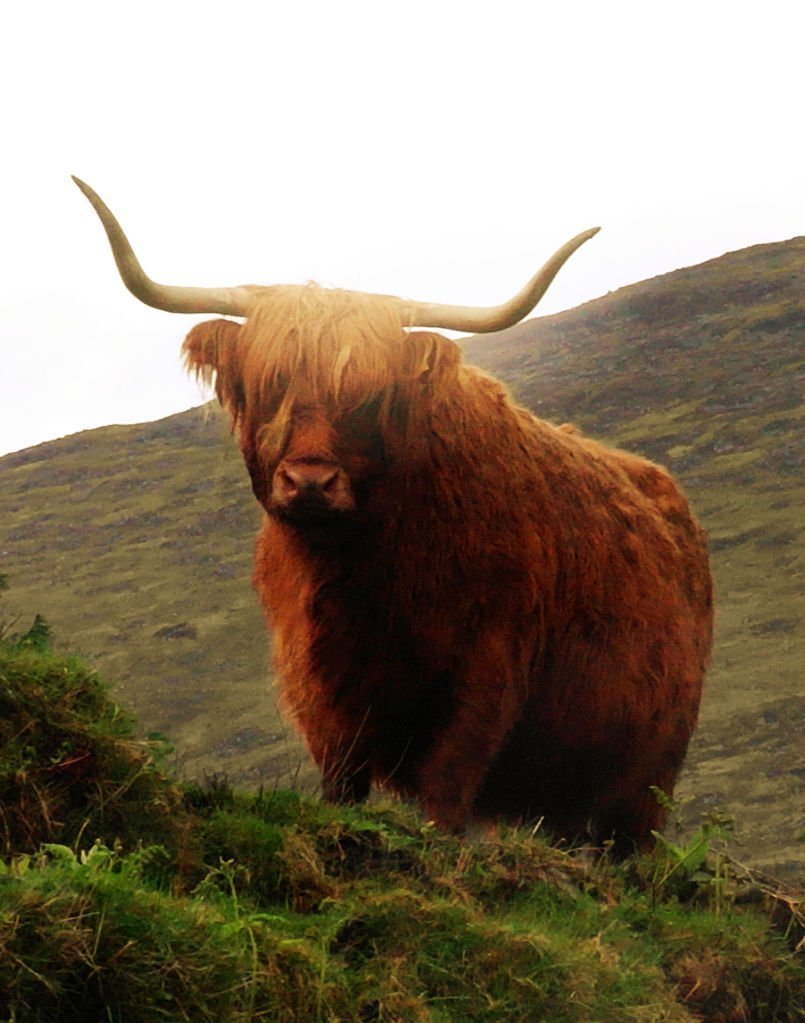
There are many icons of Scotland. Thistle, bagpipes, tartan, shortbread and so on. And the Highland cow. Yes, nothing says Scotland like this hirsute bovine. (Thought I’d get the synonym out of the way early on.)
Actually, those horns and the long fringe are a visual cliche. For instance, no Scottish commercial art gallery or gift shop is complete without a mandatory portrait of a hairy coo staring out of its frame. Tourists love ‘em.
‘The beasts’ are Hielan Coos
OK, let’s sort out the words before we start. Coo is Scots for cow. Hielan (sort of rhyming with ‘feelin”) is the way we pronounce Highland. (At least, sometimes. It depends on how Scottish we’re feelin.)
And ‘hairy’ is exactly how we pronounce ‘hairy’ – and hence hairy coos…Oh, and sometimes I’ll refer to them as ‘the beasts’. I’m not sure if that’s a ‘Scoticism’ or not, but just indulge me, will ya?
Where to See Highland Cows

I’m pretty sure that most drivers of Scottish tour buses and other tour guides have their own locations – so that when asked where Highland cows can be found, the photogenic coos are on hand nearby and guaranteed to have their clients tumbling out of their seats and trying to get selfies with them.
Hairy coo selfies are not recommended. Those horns are dangerous if your photogenic coo suddenly swings his/her head. So don’t get too close.
Just below, are a good selection of tours most of which, I’m pretty sure, will have the coos somewhere in view at some point! Take a look…
Hairy Coos – there are lots about!
OK, OK, I knew you’d want to get to the main question. You came here for some views of coos. (Actually, further down the page you’ll find some interesting stories about Highland cattle and how important they were in the Highlands.)
But for now: where can you view Highland cows? Basically: all over Scotland.
If you were to ask me the very first location that first spring to mind, then I’d say they are in the fields near the south side of Loch Achray in the heart of The Trossachs.
That’s where the A821, the Duke’s Pass road drops down to loch level (if you are coming from the south. You can even see the beasts in this Google streetview link of the spot. They were there the last time I looked. Honest.)
But I only unfairly mention these as they are easy to see from a main Trossachs ‘tourist route’, especially for day visitors from Edinburgh and Glasgow. (Heck, I hope they’re still there!)
City coos
If you want the closest to Edinburgh, then there are Highland cattle at Swanston Farm. So, that’s where to see Highland cows within five miles (eight km) of the city centre, tucked below the Pentland Hills – the little range you see to the south of the city.
For Glasgow, it could be the Highland cattle in Pollok Country Park. Again, easy to reach from the city centre.

Where to see Highland Cows. Uhmm. In the Highlands.
Aside from three suggestions in easy to reach popular locations, there are are actually too many to list. I’ll confine myself to locations in the Highlands.
That way you get a more authentic picture – though you can see the beasts in the south of Scotland too.
At the Rothiemurchus Highland Estate, for instance, close to popular Aviemore, you can go on a kind of coo safari to see them in the fields, with the impressive backdrop of the Cairngorms in shot as well.
Johanna reports them from the field actually adjacent to the large car park at the Culloden Visitor Centre near Inverness.
(Though even if they’re not there remember that Culloden is a great visit anyway.)

And totally staying on the tourist trail, they are often to be seen adjacent to the Kilmahog Woollen Mill at the north end of Callander, which brings us back to the Trossachs again.
Well, let’s do a few more at random. They do buggy tours at Kirkton Farm by Melvich, west of Thurso, if you are travelling the north coast. I’ve photographed coos on the road to Applecross (the low-level way) from Shieldaig. The picture from that day is higher up the page.
And I’ve had to stop for them on the unfenced road on the upper part of Glen Lyon in Perthshire. (I mean I had to stop the car as they were sitting in the road.)
Not too far away, there are quite a few places you can see them from the main A82, the road to the west, around, say, Crianlarich. They don’t sit on the road there though, fortunately.

Our favourite place for Hairy Coos
If you are heading for the Isle of Skye (and so many of you will be, in spite of our enthusiasm for other Scottish islands) then you may want to make a wee diversion to Duirinish. (It isn’t that far from the Skye Bridge if you are driving, though it also has a nearby railway station.)
This fascinating little crofting township – very much ‘all of a piece’ and almost without a jarring note, architecturally speaking, has its common grazings right in the centre of the settlement.
And that’s where to see Highland cows and sheep together. I expect you to run amok with your camera/phone – but be sensible as well and don’t get too close. And watch where you put your feet.
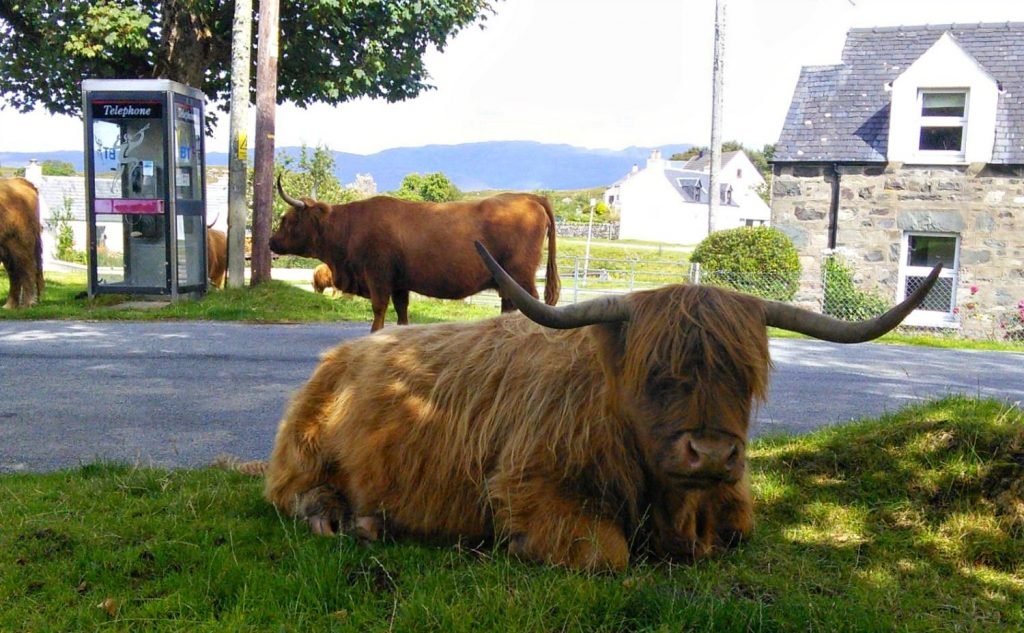
Oh, and we have two pages about sheep on this site – see the end of this paragraph. One page is about sheep in Scotland in general, the other, for real hard-core sheepoholics, is on the North Ronaldsay seaweed-eating breed. But we’ve plenty more coo facts on this page.
In conclusion aboot coos: there is this guy in Plockton who does seal-spotting trips. He says that if you don’t see any seals from the boat you will get your money back.
I’m awfully tempted to say that if you travel in the Highlands of Scotland and don’t see any Highland cattle, then you should get your money back from somebody.
But not from me, obviously, as you are learning all this stuff for nothing… (or you might like to make a wee donation!)
And now, if you want to discover more about hairy coos…read on…cute coo-pics too.
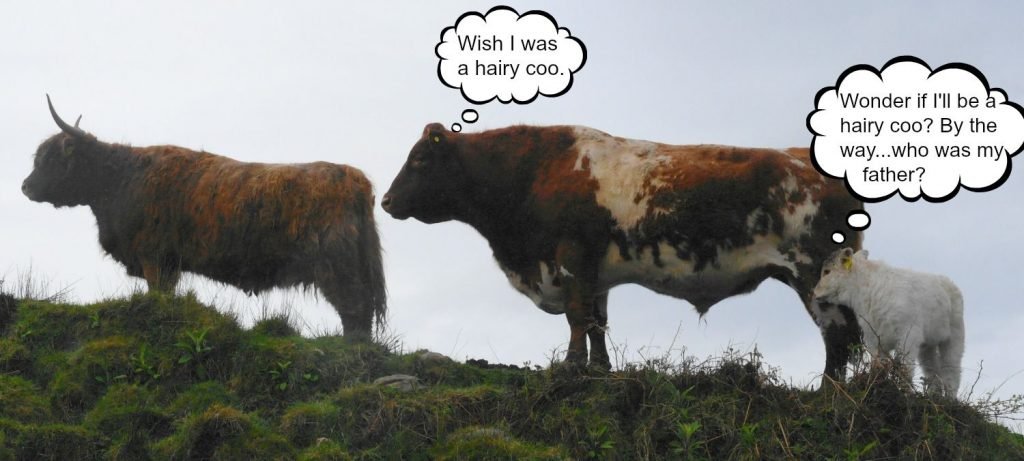
Ancestry of Highland cattle
The ‘original’ Highland cattle were comparatively small and black and sometimes called kyloes.
Some say the name derives from the association with the straits that separated, for example, Skye from the mainland, the Gaelic name for which was caolas or kyle.
And, to get to markets in the south, the cattle were driven into the water – and had to swim.
It was the original native kyloes that evolved – or were bred – into today’s Highland cattle. Though today’s animals are larger, they have the same hardiness and ability to thrive on poor ground – so they are still suited to their northern terrain.
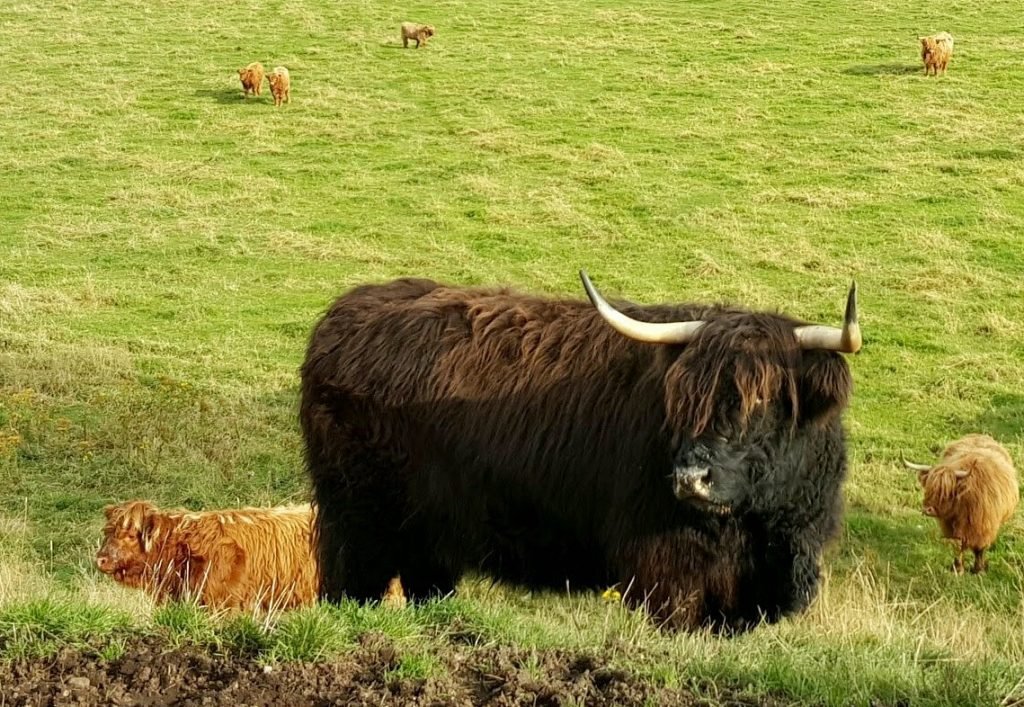
Old Queen Vicky loved her coos
As for colour, they aren’t always red. As mentioned above, originally the native cattle were predominantly black. Some say it was Queen Victoria who remarked that she preferred them red, way back in the 1840s.
Inevitably, in the usual sycophantic please-the-monarch fashion, the reds started to be selectively bred. Vicky even had her own herd at Balmoral Castle, though I doubt she’d be seen mucking out the byre very often.
In fact, today’s Hielan Coos can be black, brindled, yellow, dun or acrylic (except that kind is usually only seen in souvenir shops) as well as red – and still be pedigreed.
Highland Cattle Droving
When more peaceable times eventually followed on, the practice of rearing beef in the north and selling it on in the south became widespread. A network of drove roads ran like arteries through Scotland and you can read all about these on our dedicated cattle droving page.
Remember too that many of the Highlanders with cattle skills emigrated west and in turn both them and their descendants became the herders, ranchers and cowboys of the New World. (They also took their Scottish music with them.)
In turn, the arrival of the railways, then road transport, finished the practice of moving cattle from the Highlands on foot. But the hairy coos you see today are part of the heritage of the Highlands and a link with the old ways.
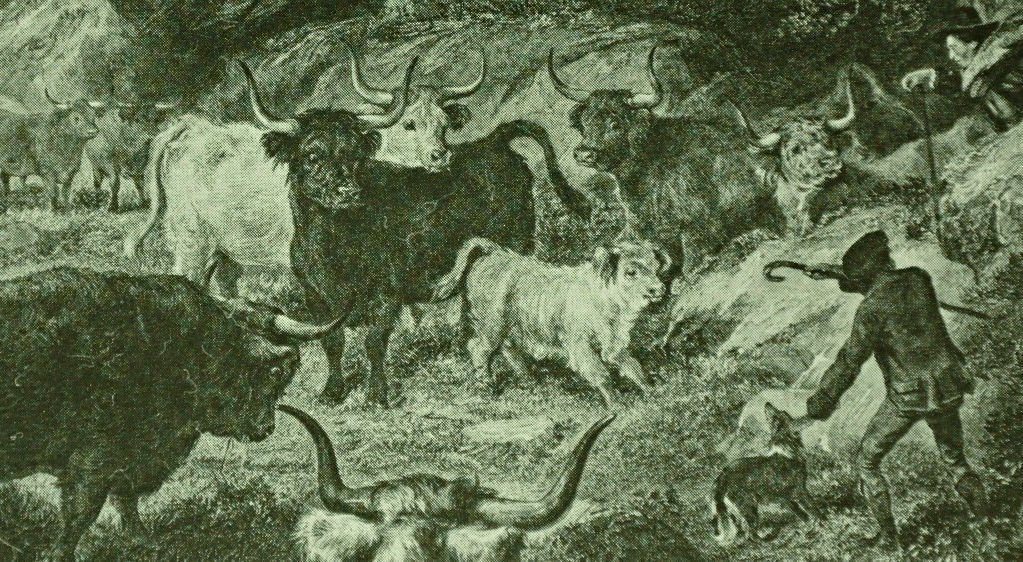
Scottish cattle droving was once important in our economy, notably when Crieff ‘tryst’ in Perthshire was a major cattle market. Fortunes were made and lost, often the best beef went south to England. Eventually the railways arrived and ended the trade there.
So, you like cute coos, eh? Well, our sheep are nearly as photogenic…take a look.
Sheep in Scotland – in pursuit of the cute
There are more sheep than people in Scotland, so finding some cutesy ones to photograph should be easy, in Highland or Lowland. Here is a beginner’s guide to road-side sheep-spotting in Scotland. How to tell a Blackface from a Cheviot, for instance. The clue is in the name.
OK, but how long should I spend in Scotland (whether or not you visit for the coos).
Buy the best bits of must-see-scotland.com advert-free!
Like the tell-it-like-it-is-approach? The most helpful and entertaining pages on this website are now available as ebooks covering many aspects of travel in Scotland.
Get them right here in my ebookstore for £1.99 each and look out for future titles!
Download and enjoy each ebook for the price of a (cheap) coffee from CostBucks.
Read them off-line. (Well, you know what the signal can be like in the Highlands…)
Midges, weather, tipping, driving, best time to visit and more…essential background for your trip to Scotland. Fully illustrated in colour but easy to read on your smartphone or e-reader.
Buy Now – £1.99All the favourites in Scotland: Highland cows, puffins, dolphins and more – plus top ten lists – best beaches, views, walks – positively a treasury of information to make your trip a success…
Buy Now – £1.99

